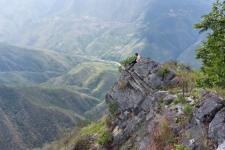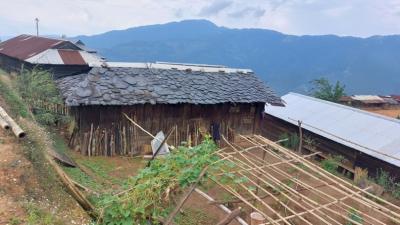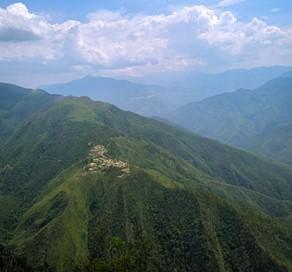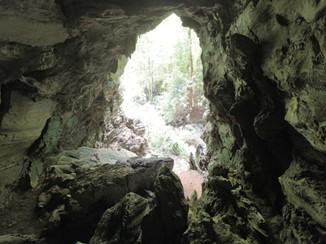Cross-border bonds

The Myclimate Research Team in Nagaland is conducting a project to study the experiences of local communities with climate change in the border region between Burma and Nagaland in Northeast India. The research focuses on how these communities adapt and coexist with climate changes, their local customs and beliefs, and how they manage impacts to increase their resilience. In May 2024 the team made their first trip to Mimi Village, a border village to expand their research in the region.
Path of Adventure
As we pass through the sub-division of Meluri, we navigated a series of challenging roads and trails to reach Mimi Village. The route includes a mix of sharp, rugged rocky paths and undulating dirt roads shaped like various types of basins. Throughout the journey, the terrain presents a striking view with layered rock formations and steep, sheer cliffs. In some areas, entire mountains stand bare, devoid of vegetation, revealing only rocky crags.
As a border village, there is an Assam Rifles checkpoint set up by the Indian government for security reasons. All vehicles passing through this checkpoint are stopped, and travelers must provide the necessary information requested by the authorities.
Upon arriving at the village guesthouse, the health workers from the sub-divisional health department were seen conducting medical check-ups. As soon as the researchers had unpacked their bags in the guesthouse, they set out for a walk. Stone house roof in Mimi village

Some houses are made of stone with thatched roofs, but most of the houses are built with local woods. Only one newly constructed brick house was spotted in the entire village. The village is situated on a hillside, giving it a tranquil and serene atmosphere. Many houses appeared unoccupied – some were staying in towns to care for their children while attending education. Others were in the field working.
In the village center, there is a large open ground, featuring a newly constructed and prominent church. We were later told that the village only has Baptists and that no other religious denomination is accepted. This is even written into the village rules and regulations. On the southeast side of the ground, there was also two Village Guard watchtowers. In Indian border villages in Nagaland, village guards are local residents hired to protect against infiltration and smuggling. They assist law enforcement and military, trained by the Indian government to monitor, stay alert, and respond during emergencies. The official purpose is to enhance border security, but in remote areas of Nagaland, they also serve to remind locals of the presence of the state.
The researchers stayed at the Mimi Tourist Guest House located above the newly constructed church, the only guesthouse in the village. Maps labeled "Hot Spot of Mimi Circle" and "Important Places at Mimi" were displayed on the walls of the reception area. After the health workers left, the researchers had conversations with some village elders in the guesthouse's reception area on topics such as climate change and its impacts, land ownership and relationships across the border to Burma.
During this visit, the researchers conducted interviews and informal discussions with village elders, including the Head Gaon Bura (Head GB), Village Council, President of the 8 Villages Joint Council, a religious leader, and some ordinary villagers. The Gaon Bura in Nagaland is a government-appointed village leader responsible for administration and community matters. This role originated in the colonial period to facilitate governance and dispute resolution between the British and local communities. The Mimi Head Gaon Bura frequently visited the guesthouse where the researchers were staying, resulting in extensive conversations with him.
Village landscape
The head Gaon Bura explained that Mimi Village is referred to as the "parent village" or the original village of seven villages in the area. Additionally, it is the last village in India on the Burma border. According to local accounts, Mimi was originally established in 1955 under the name Longpfutsa, situated below the current village location. Later, when the village moved to its current location, 50 percent of the households relocated to the Burma side.

Some families also later branched out from Mimi Village to establish new villages on the Indian side. The reason for this was to to expand shifting cultivation land to more areas and by living in new villages, people could be closer to the land. At the same time having a recognized village also enables access to government development funding.
The first village was founded around 1970, and the last one was established in 2012 which is the seventh village split from Mimi. Thus, Mimi Village has become known as the parent village not only for the entire Mimi range but also for the Naga people who speak the Longphuri language on the Burma side.
Currently, there are 13 villages in the Mimi Range. Like ther regions of Nagaland, there is increble linguistic variation between them. Although all these villages belong to the Yimkhiung Tribe, they speak different dialects. It was noted that 2 villages speak Chirr language, 3 villages speak Makury language, and 8 villages speak Longphuri language. Among them, Longphuri language speaking villages are offshoots from Mimi village. The remaining 5 villages were settled by people who migrated from other places and were given land by Mimi. As a result, the Longphuri language speaking villages do not have defined borders between them and are managed under a single land administration system. However, the other 5 villages were given defined borders when the land was donated, and their land management remains separate.
The villages which speak Longphuri language are individually listed in the Nagaland state government records and have separate administrative and judicial functions. Whenever a new village is formed from the parent village, Mimi, the village leaders for the new village are chosen from the three clans within the parent village according to custom. The responsible individuals from the parent village, along with religious leaders, offer prayers and blessings before allowing the new village to govern itself. The leaders of Mimi support the creation of new villages. They explain that due to the vastness of the village's territory, it is difficult to oversee and visit some distant areas annually. By establishing new villages, they ensure that nearby areas are properly managed and overseen by the closer villages.
Joint Forest Management
The 8 Longphuri language speaking villages have formed a Village Joint Council to manage and preserve the natural environment. Among these villages the administrative and judicial functions are separate, but the village boundaries are not individually demarcated. The joint council was established 27 years ago in response to the extensive logging by local residents. Logging led to the loss of many large trees, which was seen to have caused warming of the region's climate and the silting of streams. This meant a ban on logging in communal lands. According to the head Gaon Bura, a ban for logging on individual land was also implemented, but just last year when all the big trees were gone in the village. The village council secretary, however said that the ban on individual land had been in place for 10 years. The joint council has decided that logging is permitted only for personal use in house construction and among the villagers themselves. Selling wood to outsiders is also prohibited. Additionally, hunting for commercial purposes and extracting forest products are banned. Previously, traders from Burma would buy coveted forest products and animal products such as pangolin’s scale and bear claws, which has now been prohibited, as a measure to try and protect the local flora and fauna.
Mimi Range is home to numerous natural attractions, such as natural caves, waterfalls, and limestone mountains. Following a suggestion from a researcher who conducted studies in the village over ten years ago, these sites have been preserved as tourist attractions. The Village Councils, Gaon Buras, and the 8 Village Joint Council collaboratively manage these areas.
Visitors are required to pay fees set by the 8 Village Joint Council and obtain a certificate from the council to visit these sites. The fees are also paid to the 8 Village Joint Council.

Cross-Border Bonds
Almost everyone met in Mimi village showed no particular reaction when Lu Chi was introduced as a Naga researcher from the Burma side. Their statements and experiences clearly indicated that they had been traveling freely to and from Burma since time immorial. However, this freedom of movement has been much more limited after the Burmese military staged a coup in 2021. A resident of Mimi village married to a Para Naga tribe from the Burma side reflected on the difficulties facing people who have local connections across the border since the coup. She noted (in the Burmese language), 'I have family in Burma, so I used to visit every year. When I went there I brought some snacks and washing powder from here, and when I came back to village, I brought some fish paste and green tea leaves. But now, because of the political situation, I don't dare to go, and my family members are not allowed to visit either.'
A man around 50 years old from the village also commented on the changes to movement since the coup, noting 'In the past, people from Burma used to come and sell dogs, chickens, pigs, and chilies here. On their way back, they would buy some Indian products such as thread and beads from here. But now, they don't come anymore, and we don't get to eat Burmese food anymore.’
While people from the Indian side of the border have significantly reduced traveling to the Myanmar side, we realized that villagers from the Myanmar side have been coming to the border villages on the Indian side for their safety. One morning, the researchers met three young people staying at the house of a relative from Burma. By the afternoon, there were four, and when asked, they said they’d arrived that morning for a visit. When the researchers talked with those four young guys, they said they were going to hunt birds and they headed into the forest. Watching them, it seemed they were living in Mimi just like in their own village.
It was observed that when the villagers could no longer travel to villages in Myanmar due to security concerns, the religious leader connected with religious organizations on the Myanmar side and managed to facilitate some travel. When speaking with the religious leader of Mimi village, he mentioned that in late 2023, he traveled to Burma for religious purposes. He added that the Mimi Christian Church has plans to send a missionary to the Naga region in Burma once the political situation stabilizes. However, after the military regime passed the conscription law in early 2024, the political situation has become increasingly unstable, and even the religious leaders are avoiding travel to Myanmar.
People are generally aware of the political situation in Burma, and they try to help their relatives on the Burma side as much as they can when asked. A 56-year-old man also said, 'We are brothers, we are family. Drawing a border doesn't separate us. Even now, we try as much as we can to help those in Burma who need help.'
In conclusion, as a border village, Mimi village is highly interesting due to its economic, social, and religious connections with the people in neighboring Burma. It a fascinating place to further study how the 8 Village Council manage the natural environment and how the local residents experience and adapt to climate change.

